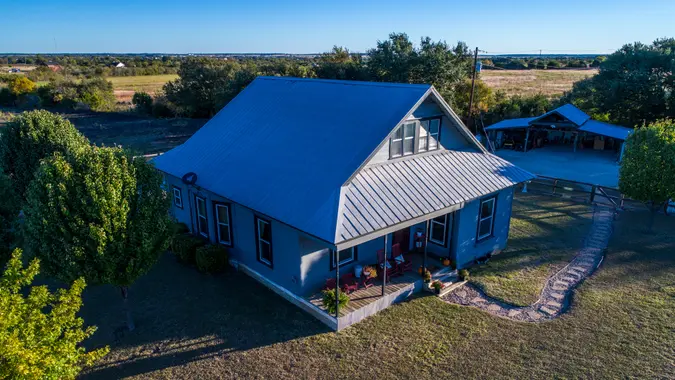How Much Down Payment Should You Save For A House?

Commitment to Our Readers
GOBankingRates' editorial team is committed to bringing you unbiased reviews and information. We use data-driven methodologies to evaluate financial products and services - our reviews and ratings are not influenced by advertisers. You can read more about our editorial guidelines and our products and services review methodology.

20 Years
Helping You Live Richer

Reviewed
by Experts

Trusted by
Millions of Readers
Saving up for a down payment is one of the most challenging parts — if not the most challenging part — of buying a home. It’s also time-consuming, taking anywhere from 2.56 years in the least-expensive market to more than 12 years in the priciest market to save up a 20% down payment on a median-priced house, according to a study from RealtyHop. But a little creativity can help you shave years off the time it takes to come up with the funds.
See: 3 Things You Must Do When Your Savings Reach $50,000
What Is a Down Payment?
A down payment is one of the most critical steps in buying a house. Here’s what you need to know.
Definition of a Down Payment
A down payment is the initial payment you make when purchasing a home. It’s usually reflected as a percentage of the purchase price, with 20% being a common objective. With the average home in the U.S. valued at $355,328, according to Zillow, a down payment of nearly any percentage amounts to a sizable sum.
Importance of a Down Payment
There are two main reasons why a down payment is so important. First, it reduces the amount that you need to borrow. If you’re purchasing a $400,000 home and make an $80,000 down payment, for example, you’ll only have to finance $320,000, not $400,000. Not only will this reduce your monthly mortgage payments, but it may also influence the actual terms of your loan. As lenders take on less risk with larger down payments, you may be able to get a better interest rate on your loan.
Another reason why down payments are important is that they allow you to build equity in your home immediately. With a 20% down payment, for example, you’ll likely still have equity in your home even if the market temporarily goes down. With a 0% down payment, on the other hand, the slightest decline in the housing market could leave you “upside down,” owning a house that’s worth less than the amount you owe on it.
How Much Should You Put Down on a House?
Although each person’s financial situation is different, there are some industry-standard recommendations and requirements regarding down payments.
Common Down Payment Percentages
For decades, traditional advice has suggested putting 20% down when buying a home. As described above, this can not only improve your payment terms, reduce the cost of your monthly mortgage and build equity in your home, it also allows you to avoid private mortgage insurance. In most cases, you’ll have to pay an additional 0.5% and 1.5% of the original loan amount in PMI to help protect your lender against default.
Even though putting 20% down is the safe way to go, many borrowers today make much smaller down payments.
Average Down Payments Today
According to NerdWallet, the average first-time homebuyer only manages to scrape together an 8% down payment. Repeat buyers fare much better, putting down an average of 19%. However, neither of these groups, on average, meet the long-standing recommendation of making a 20% down payment.
Minimum Down Payment Requirements
There are many different types of mortgages, and they all have different requirements.
Conventional Loans
Conventional loans comprise the vast majority of the home mortgage market. While a 20% down payment is typically recommended, according to NerdWallet, minimum down payments can be as low as 3%.
FHA Loans
As the name suggests, FHA loans are backed by the Federal Housing Administration. These loans require as little as 3.5% down, according to Rocket Mortgage. You’ll need a credit score of at least 580, and you must prove steady income. You’ll also have to pay a monthly mortgage insurance premium, which is similar to private mortgage insurance (PMI).
VA and USDA Loans
VA loans are issued by private lenders but are guaranteed by the Veterans Administration. They are available for veterans and active-duty service members, often with no down payment requirements.
The U.S. Department of Agriculture offers loans with as little as 0% down for rural property buyers. The program is designed to assist low- and very-low income individuals buying housing in rural areas by providing payment assistance subsidies.
Factors Influencing Your Down Payment Amount
Certain variables can affect how much you could or should put down on your mortgage. Here’s what you need to know.
Personal Savings and Budget
Every person’s financial situation is unique. If you don’t have enough money for a sizable down payment, you’ll have to either wait until you save more or simply put less money down. Be realistic about how much you really have available to put down now, and don’t forget to factor in your future financial needs as well. It’s not worth liquidating everything you have to make a 20% down payment if it means that you won’t be able to comfortably feed your family or pay your bills.
Loan Type and Lender Requirements
Different home loans have varying down payment criteria. Some loan programs, for example, allow you to put as little as 0% down. Lenders often have specific requirements for down payment amounts or other qualifying criteria, so be sure to check around to see what your available options are.
Private Mortgage Insurance (PMI)
As described above, private mortgage insurance is an added expense that you should expect to pay if you’re putting less than 20% down on your mortgage. As the risk of default rises with a smaller amount of equity in your home, lenders require PMI in order to protect themselves. Once you build up at least 20% equity in your home, you can have these added costs removed. However, you can avoid the added expense right off the bat with a 20% down payment.
Pros and Cons of a Larger Down Payment
Every financial transaction has its pros and cons. Here are things to consider when choosing the size of your down payment.
Advantages
- Lower monthly mortgage payments
- Potentially better interest rates
- You don’t have to pay for PMI
Disadvantages
- Money is locked up in the house and unavailable for other investments
- Can’t easily access funds for emergencies
Down Payment Assistance Programs
Need help with a down payment? You may be able to get some financial help.
Federal Programs
Fannie Mae and Freddie Mac are two U.S. government agencies that provide assistance to homeowners, including loans with lower down payment requirements.
State and Local Programs
Many states offer assistance to first-time buyers. You’ll have to check with your state’s housing authority to see what options may be available. In some cases, you may be able to find local assistance as well. States and municipalities may offer grants, loans or tax credits, especially for first-time and/or low-income home buyers.
Employer-Sponsored Programs
Your employer may be able to help you with the down payment on a primary residence, whether by granting you the funds or offering them as a fully repayable, forgivable or deferred-payment loan. The money can come directly from your employer or from a credit union it’s affiliated with. But if you’re using a conventional loan, the employer must already have an employee assistance plan in place — it can’t simply gift the funds to you as a special favor or bonus. Check with your HR department for availability.
Tips for Saving for a Down Payment
Nearly everyone can use a little help when it comes to saving more for a down payment. Here are some suggestions.
Create a Dedicated Savings Plan
In addition to any general savings you have, such as for emergencies, retirement or education funding, you should keep a distinct, separate savings account for your housing down payment. This can help you avoid any temptation to commingle your funds or use them for any other purposes. Set specific goals and timelines along the way to keep yourself on track and accountable.
Along those lines, it’s a good idea to automate regular transfers to your dedicated savings account so that you never forget to save. Human nature being what it is, it’s all too easy to overlook a transfer or two or “borrow from yourself” for other reasons, promising that you will pay it back later. However, this can completely derail your savings plan. With automated transfers, all you have to do is set them up once and you’ll never miss a deposit.
Explore Additional Income Streams
The easiest way to boost your savings and reach your down payment goal faster is to increase your income. If you can pick up a side gig that pays you an extra $1,000 per month, you could save an additional $12,000 per year. That can go a long way to helping you reach your savings goal.
In addition to looking for freelance work or part-time jobs, consider asking your employer if you can work extra hours or perhaps sell some unused items you don’t need to generate extra savings.
Reduce Unnecessary Expenses
Reducing your expenses can serve the same purpose as increasing your income. Every dollar you don’t spend is a dollar that you can save instead.
Common ways to reduce your costs include eliminating unused or expensive subscriptions or cutting down on dining out. You could also move to a lower-cost area or get a lower-priced vehicle. Check your monthly budget and see what additional areas you can trim.
Our in-house research team and on-site financial experts work together to create content that’s accurate, impartial, and up to date. We fact-check every single statistic, quote and fact using trusted primary resources to make sure the information we provide is correct. You can learn more about GOBankingRates’ processes and standards in our editorial policy.
- Fannie Mae. "FAQs: 97% LTV Options."
- Fannie Mae. 2023. "B3-4.3-04, Personal Gifts (09/06/2023)."
- Freddie Mac. 2023. "Interested party contributions."
- Realtor.com. 2023. "Down Payments Fall From Recent Peak."
- Rocket Mortgage. 2023. "Gift Letters For Your Mortgage: A Guide."
- National Association of Realtors. 2022. "First-Time Home Buyers Are Vanishing From the Market."
- Chase. "Guide to jumbo loan down payments."
 Written by
Written by  Edited by
Edited by 

























